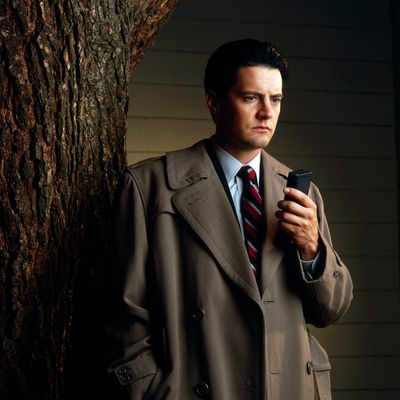
The news that David Lynch and Mark Frost are reviving Twin Peaks brings a particular entertainment narrative full circle. We truly are back where we started. Well, almost: The show began life on a network (ABC) and is continuing it on cable (Showtime).
The arty, boundary-breaking drama as we now know it wouldn’t exist without Twin Peaks, which ran two seasons (one and a half, really) from 1990 to 1991. The series is canon now. Everyone knows what it was, and is, and meant, even if they haven’t watched a frame. Everything from The Sopranos to American Horror Story owes it a debt. So it seems only fitting that it would finally reemerge on the medium that birthed it. (Lynch made an R-rated follow-up feature, Twin Peaks: Fire Walk With Me, which finished the story interrupted by ABC’s cancellation.)
And yet, as incredible as it now seems, there was a time when ABC was thought reckless, indulgent, or just plain stupid for giving Twin Peaks a green light. It was beyond surprising to have such a program on a major broadcast network’s schedule. You simply didn’t expect to see that sort of thing in a venue like that, any more than you expected to see a James Surls sculpture in a shopping mall or a Lucien Freud painting hanging on the wall at a car wash. Network television was for keeping audiences anesthetized long enough to sell them things. It was a venue widely believed to be inhospitable to art generally, and the ostentatiously conceptual kind in particular. Exceptions snuck through, such as Mary Hartman, Mary Hartman, the first season of Miami Vice, and Moonlighting. But they were rare, and none of them were as off-putting, as eerie, as “what the hell am I looking at?” as Twin Peaks, a show that gave its FBI agent hero Dale Cooper (Blue Velvet star Kyle MacLachlan) clues through intuition and cryptic dreamworld statements, such as, “Where I’m from, the birds sing a pretty song,” and “That gum you like is going to come back in style.”
If you’d seen Lynch’s 1986 critical darling Blue Velvet or any of his previous features (Dune, The Elephant Man, Eraserhead). you were doubly surprised to see such a program nestled amid procedurals and three-camera sitcoms. What possessed ABC? Nothing about Lynch said “network television.” There was no way one could look at his work and think, Ah, yes — the sensibility that gave us Dorothy Vallens and Frank Booth and the mechanical robin and the Roy Orbison karaoke scene in Blue Velvet would be a perfect fit for a commercial broadcast network.
Sure enough, when Twin Peaks debuted back in spring of 1990, many observers remarked not just on its boldness, but on its strangeness — and not just because it was a shockingly violent, expressionistic, often surreal program that mocked soap operas while satisfying their conventions. Lynch had worked in that mode before — notably in Blue Velvet, with its “evil in a small town” story line and “Is he kidding or not?” tone — but it wasn’t commonplace on commercial TV in 1990. The mere fact of its existence was weird, and it never entirely stopped seeming weird. That’s why the ratings fell throughout season one after a blockbuster premiere, and it’s why critics and audiences alike lost patience with the series: Once they figured out that Frost and Lynch were in no hurry to provide closure on the question of who killed Laura Palmer — and that the writers and directors were always more interested in atmosphere, performance, and head games than plot — they checked out.
People like to say “The world wasn’t ready for X” when praising a groundbreaking work. In this case, it’s true. But pretty soon after, it was no longer true. Three years after Laura’s body was discovered wrapped in plastic, the same network that green-lit Twin Peaks debuted NYPD Blue, with its profanity and nudity and David Milch soliloquies, and Fox debuted The X-Files, which channeled Peaks’s eeriness, extreme violence, and sardonic humor (and many of its cast members as well, including star David Duchovny, who played a cross-dressing FBI agent in season two). By the late ‘90s, we saw a vibrant mix of shows on cable and the broadcast networks, including Buffy the Vampire Slayer and The Sopranos (which paid tribute to Lynch in its dream sequences with wandering spirits and talking fish). All either stole from Twin Peaks or derived courage from the fact that it had existed and went on to do their own thing, precedent be damned. Lynch and Frost were unable to benefit from the sea change that their masterpiece helped bring about because their show had been canceled back in 1991 and written off as a mistake of one kind or another. But even though the series wasn’t on the air for long, its impact was powerful and permanent. After Twin Peaks, TV’s landscape was transfigured, made more hospitable to dreams.
A quarter century later, here we are, poised to enter Lynch and Frost’s dream again — and it will have to compete with many other dreams inspired, in whole or in part, by the daring of Twin Peaks. That gum you like never went out of style. It created the style.





